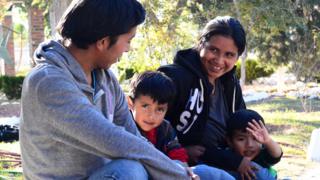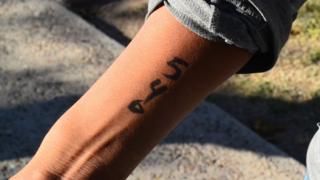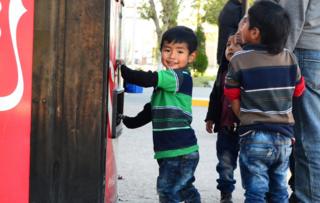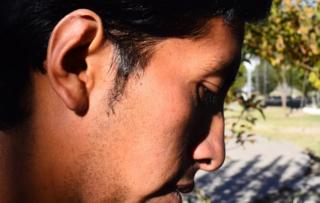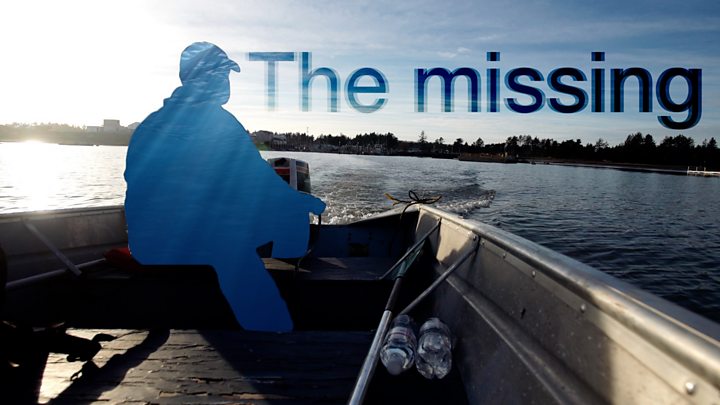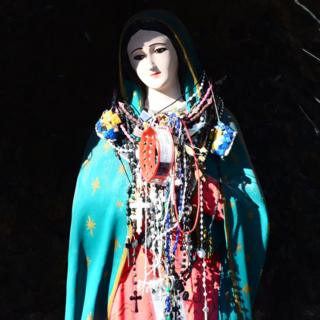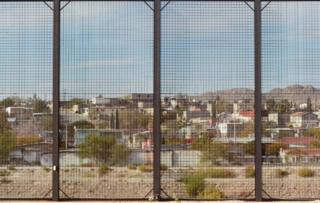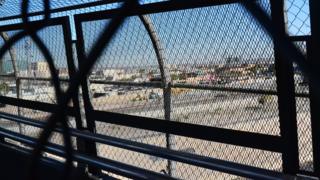The agony over an American dream
As thousands of migrants from Central America try to reach the US to seek asylum, many others are already waiting for a chance to cross the border from Mexico, the first step of an unpredictable and often traumatic process.
On a cold morning this month, Rogerio Baltazar and his family arrived in Ciudad Juárez, in northern Mexico, carrying only two old school backpacks where they had put the few things that were now everything they had – some pieces of light clothing that would do little to keep them warm and, certainly of more value, documents to prove who they said they were.
They had left their tiny village in rural Guatemala two weeks earlier, risking it all in a perilous journey by bus, sometimes even on foot, and were clearly not prepared for the weather or almost everything else they found here.
Rogerio, the 30-year-old leading the four, was tired, longing for a shower, and a better coat, too. But that could wait. What really mattered was to keep going, one last time, cross the bridge over the Rio Grande, so close, and finally reach the United States. He planned to seek asylum there and with Cristina, his 20-year-old wife, and their two sons, aged four and two, have another chance in life.
He did not know a word of English – in fact, he could barely read Spanish – or the name of a single city in the country he was desperate to get to. But “Si Dios quiere”(God willing) everything, miraculously, would work in their favour. “It’s a dream,” he said, “for my family, my sons”. They had come a long way and nothing would stop them. Yet they were not going anywhere.
Things at the border were so uncertain that, every morning, the staff of Casa del Migrante, a Catholic Church-run shelter in Juárez, searched the region’s newspapers for reports about immigration. The most relevant were attached to a large mural in the always busy reception, next to posters explaining basic rights of asylum seekers which had been framed and permanently fixed on the wall.
As the Baltazars travelled through Mexico, they were told to stop there for a rest in safety, a decent meal and information they could trust. Juárez, a dusty town opposite El Paso, in Texas, has become used – and annoyed – by the constant flow of people marching north, quite often a source of trouble. “Santa Fe bridge is closed again”, read a headline from El Diario, a local daily, displayed in the shelter. Every day seemed to bring something new.
For some time, the Trump administration – which is trying to respond to thousands of Central American migrants who are at the border with California – has claimed the system is overwhelmed and that officials are unable to process all requests. As a result, it has limited the number of asylum seekers being allowed in, turning many away. (Some activists, however, dispute this, often saying it is a manufactured crisis.)
Having no smartphone or portable radio, Baltazar seemed lost. “I don’t know anything about Trump,” he calmly said, “what he thinks, nothing”. Barred from setting up camp next to the crossings, the migrants received a number by Red Cross workers indicating their place in the queue and told to wait.
Workers at Casa del Migrante said the process during the Obama years was incredibly slow at times, but that people were not systematically prevented from crossing. It was frustrating, said Baltazar, who carried his number, 540, annotated by marker pen on his right forearm.
His next step, seeking asylum, was unlikely to be any easier. Like everyone else, he would have to prove fear of persecution or torture, a procedure known as credible fear. Those unable to understand English depend on translators who, at many times, are not even there. Help then comes through phone’s speakers.
Applicants, meanwhile, remain detained – families are expected to be kept together – until an answer is given, generally within two weeks. Between October 2016 and September 2017, 75% of the 79,710 screenings turned out positive.
Read more on Trump and immigration
The claims deemed reasonable are then referred to immigration courts. In theory, the asylum seekers are released and allowed to temporarily live in the US, often wearing electronic ankles. But people have been detained for longer, sometimes in harsh conditions, contributing to mental and physical health problems in many cases. (The Trump administration wants individuals to wait for a decision in Mexico, and not in the US.)
What comes next is a years-long wait. By March 2018, people who were given asylum had waited, on average, more than 1,000 days while there were 318,624 cases pending a decision. Some advocates say this a system seemingly designed to make people give up. If the credible fear is rejected, migrants are ordered to be removed but can try a complicated review before they are deported.
Baltazar had no idea when his turn would come. Having to stay at the shelter, he spent the night with more than 200 other men and women, of all ages, who had arrived before him with a similar goal. He feared it could be days, if not weeks, before his number was called.
In 2015, as Baltazar walked on an empty street of his poor village in Guatemala at night, he said five masked men attacked him with a knife, cutting out a small part of the top of his right ear. They did not take anything from him – Baltazar said he did not have anything for them to rob anyway – and, to this day, he knew nothing about who had done it and why.
The men quickly escaped in the dark and Baltazar did not find anyone around to ask for help. Bleeding, he ran back home where his wife improvised a way to treat the injury. It eventually healed but left a scar that he tried to hide with his shiny dark hair.
The days that followed, Baltazar recalled, had his family locked indoors, terrified that the attackers could be looking for them. Guatemala is one of the deadliest, and poorest, countries in Central America, with crime fuelled by gangs and organised groups. (It is nowhere as violent as its Northern Triangle neighbours, Honduras and El Salvador, where extraordinarily high murder rates have forced thousands of residents to leave year after year.)
But Baltazar had no option other than “seguir adelante”, carry on. While his wife took care of their then only son, he said he spent most of the time looking for work. Any work. When luck was on his side, he found something, usually helping at a construction site or plantation field, earning him a few, but much needed, Guatemalan quetzal.
The couple, together since 2013, had a second son in 2016, adding to the pressure. “We didn’t have anything,” he said. “Sometimes you eat, sometimes you don’t… No one can live this way.”
Then last October, Baltazar said unknown men tried, again, to attack him. This time, he protected his head with his arms and the suspects walked away without harming him. (From Juárez it was almost impossible to independently verify his version of events.) He no longer felt safe there. “I don’t know what they wanted,” Baltazar said. It was easy to convince his wife that they had to go. “They’d have killed me if I had stayed.”
At Casa del Migrante, for their security, Baltazar and the others were not allowed to venture outside – the shelter was some nine miles (15km) from the Paso del Norte (or Santa Fe) bridge they planned to cross. Many knew someone – a relative, a neighbour, a friend of a friend – who had made it into the US successfully, one way or another. What they heard back from America gave them some hope, at least.
For Baltazar it was his brother, who had crossed years earlier to never return – he did not explain how or his current situation. In the few times they had spoken on the phone, Baltazar was encouraged to get his family to the border and seek asylum if anything ever happened to them. Baltazar was not sure how it all worked but talked with confidence that they would be taken in, virtually a fait accompli. “They say there’s work there… I want my boys to have something.”
President Trump says the system is being abused. Earlier this month, he ordered a ban on asylum applications from those crossing the border illegally, a decision a federal judge blocked last week, saying it was an “extreme departure” from prior practice. (In the run-up to the mid-term elections, Mr Trump said the thousands of migrants travelling to the US represented an invasion and that criminals were among them.)
Many Trump supporters defend tougher policies to prevent bogus claims as officials say a large number of requests actually come from economic migrants who do not qualify for asylum. And as tensions mounted after migrants attempted to storm the border over the weekend, the president threatened to close permanently all crossings. (US border officers fired tear gas to repel migrants who, they said, were throwing rocks; MSNBC described it as a “border battle”.)
When Baltazar was not helping his wife keep their children busy, usually by walking around the shelter’s outdoor patio or playing with empty Coca-Cola bottles, he sat under the trees with other migrants, sharing stories that were invariably a mixture of never-ending misery and fear fuelled by rampant crime in their countries. It gave him, and probably the rest, a sense that everybody, in a way, was in this together.
But it also fed his anxiety. He watched with particular interest a man who had come days earlier, alone, Baltazar said, and did not even have a number to wait for. (When I visited Baltazar on a second day and his name was announced in the shelter’s loudspeaker, I saw his frustration when he was told that it was just the reporter who had come to talk to him.)
Critics argue stronger measures are unlikely to stop asylum seekers from showing up at the border, and say that, in fact, it could result in more people trying to cross it illegally, at greater danger. Workers at Casa del Migrante said they had sheltered a woman and her young son who had been caught by officials at the border days before Baltazar arrived.
Like most migrants, Baltazar, who was slim and talked slowly with a low voice, was a devoted Christian and believed that a divine force would protect them. He and his wife had survived a “difficult trip” of exhausting hot days with scarce food, carrying their sons who understood nothing of what they were going through. But God, Baltazar said, “knew everything”.
Four days after Baltazar arrived in Juárez, he stopped replying to my text messages and calls went straight to his voice mail. His 540 had been called, Casa del Migrante later confirmed, much earlier than he expected. (They did not have any other information on him.)
When we met for the first time, he said he was not worried about would happen to him once he crossed the border. “I’m scared of having to return. If I’m not allowed in, I’ll try again. In my city I’ll never live again.”
Follow Hugo on Twitter: @hugobachega
Source: Read Full Article
